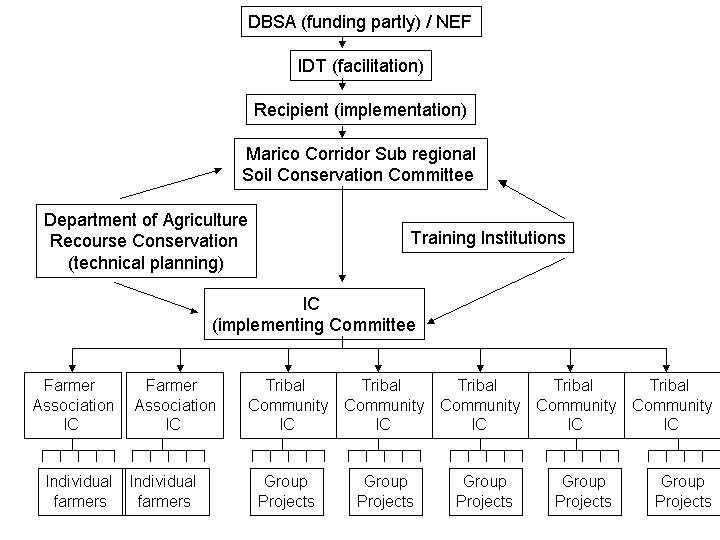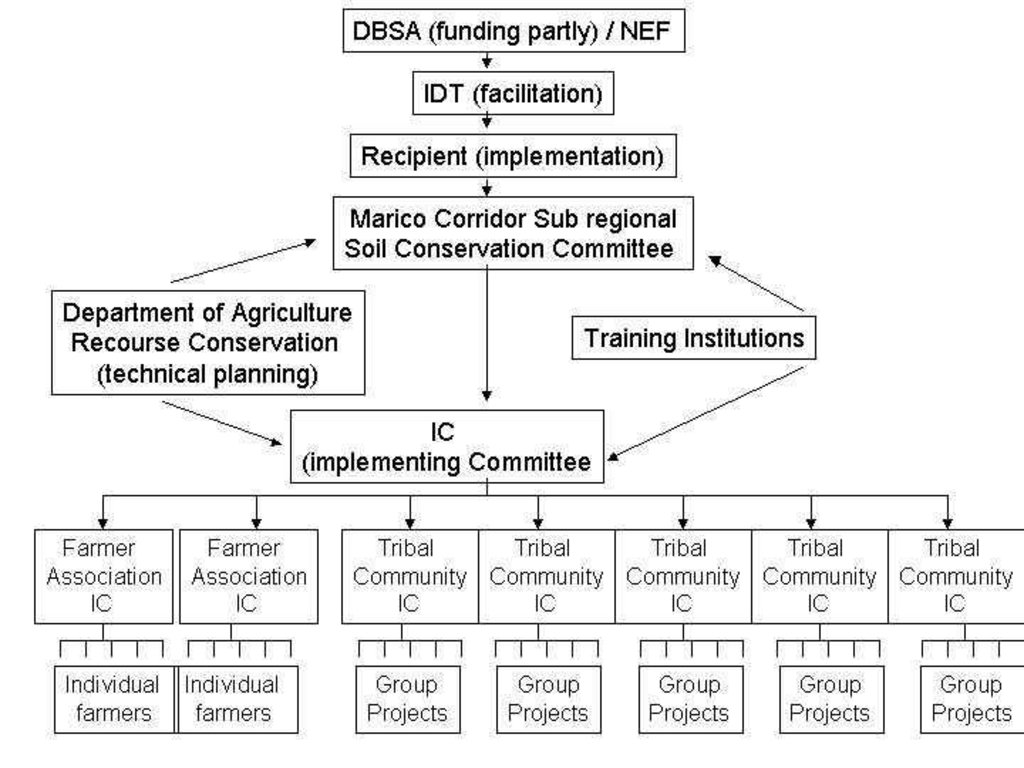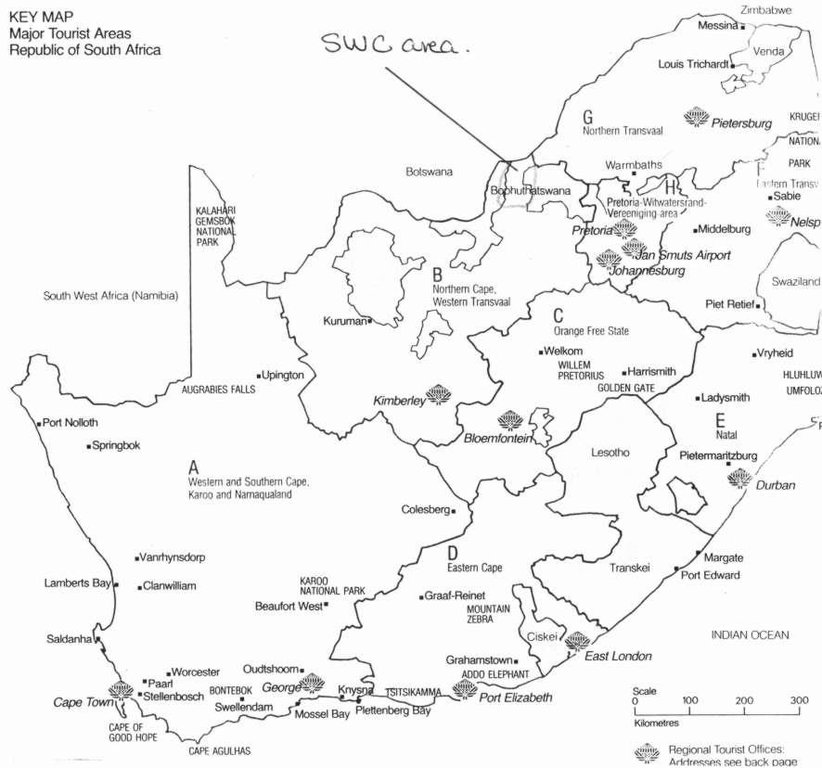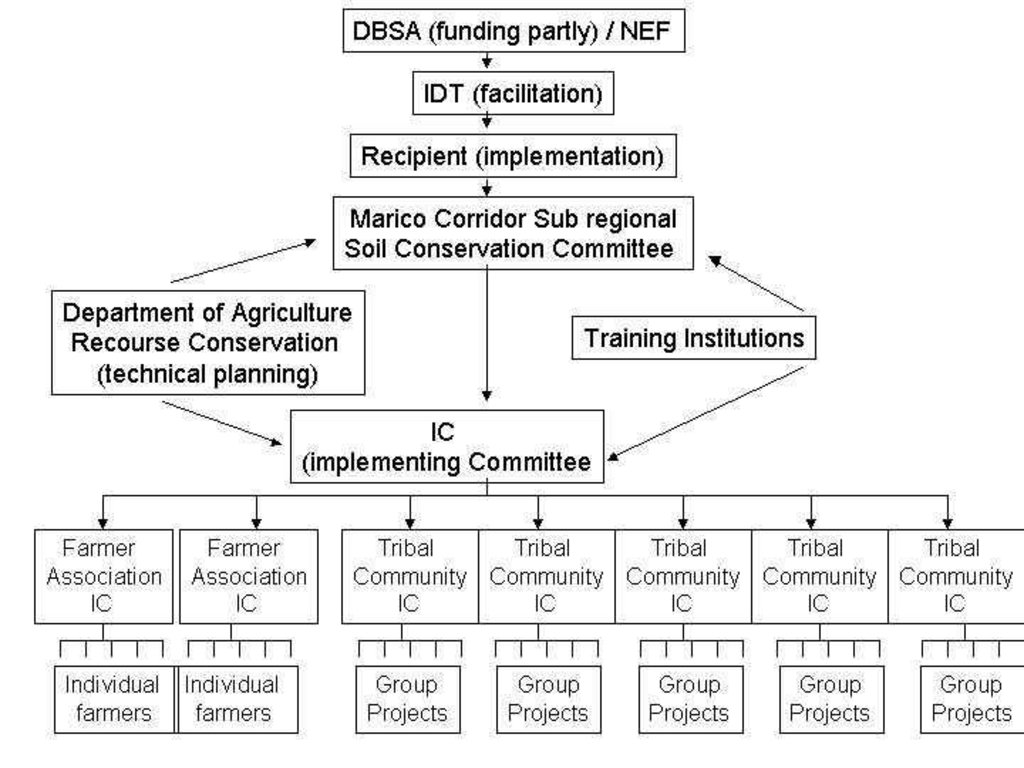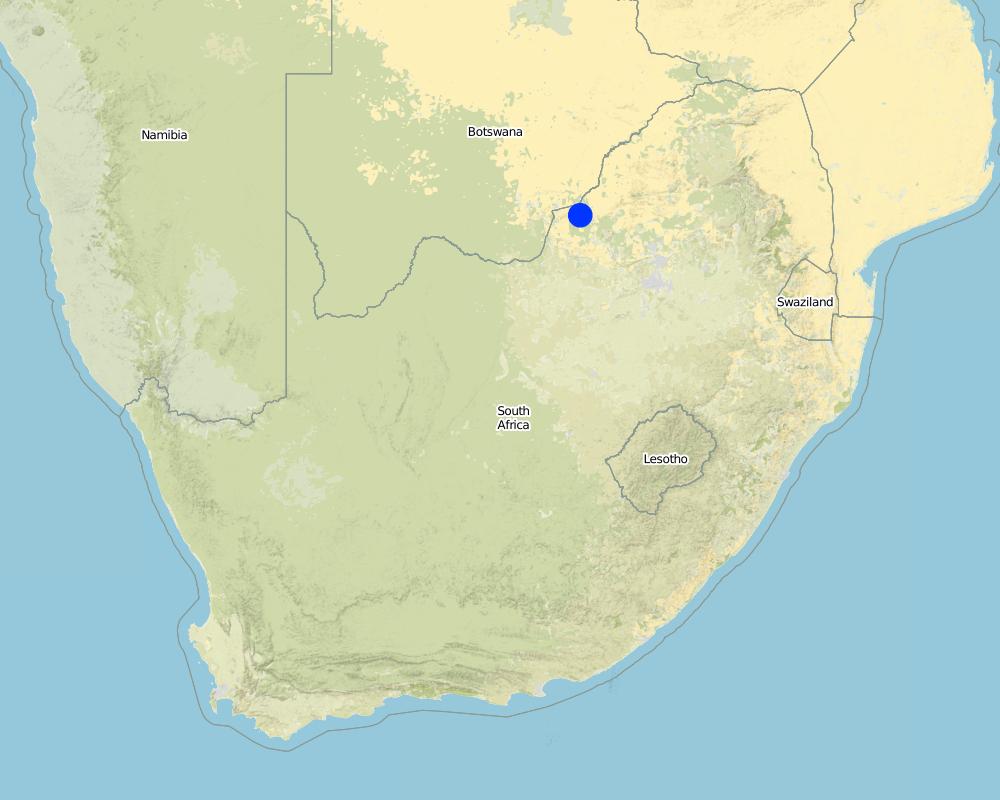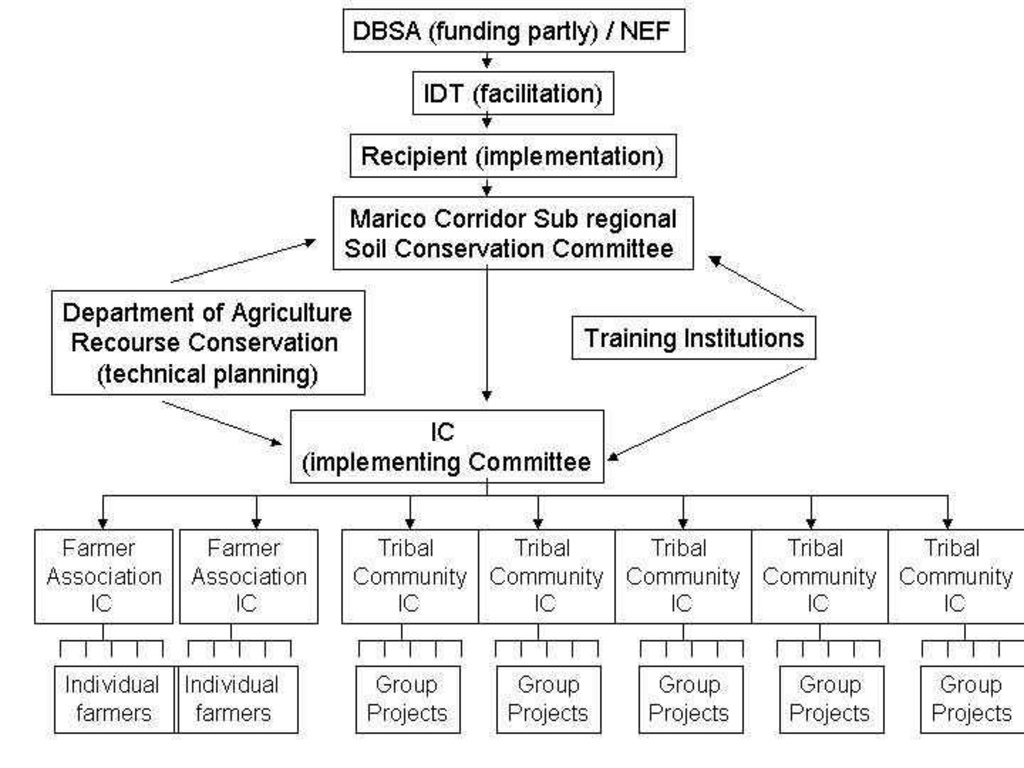Community driven Protection of the Molatedi Dam Catchment area [南非]
- 创建:
- 更新:
- 编制者: Philippe Zahner
- 编辑者: –
- 审查者: Fabian Ottiger
approaches_2345 - 南非
查看章节
全部展开 全部收起1. 一般信息
1.2 参与方法评估和文件编制的资源人员和机构的联系方式
有助于对方法进行记录/评估的机构名称(如相关)
Swiss Agency for Development and Cooperation (DEZA / COSUDE / DDC / SDC) - 瑞士1.3 关于使用通过WOCAT记录的数据的条件
编制者和关键资源人员接受有关使用通过WOCAT记录数据的条件。:
是
1.4 SLM技术问卷的参考
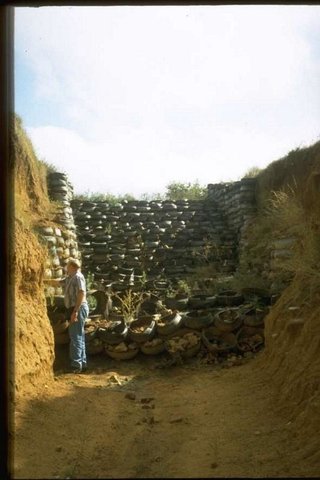
Gravity type inverted tyre structure [南非]
Stabilising of gully erosion by means of gravity type inverted tyre structures filled with stone.
- 编制者: Mirjam Staehli
2. SLM方法的描述
2.1 该方法的简要说明
Development and capacity building in participating communities through the implementation of measures to prevent topsoil losses through erosion in the Molatedi dam catchment area.
2.2 该方法的详细说明
该方法的详细说明:
Aims / objectives: Initiated by Welkom Farmers' Association through the Marico corridor sub-regional soil conservation committee. The aims were: 1) development and capacity building in participating communities and 2) implementation of measures to prevent topsoil losses through erosion in the Molatedi dam catchment area.
2.3 该方法的照片
2.5 采用该方法的国家/地区/地点
国家:
南非
区域/州/省:
North West Province
Map
×2.6 该方法的开始和终止日期
注明开始年份:
1994
终止年份(若不再采用该方法):
1995
2.7 方法的类型
- 基于项目/方案
2.8 该方法的主要目的/目标
The Approach focused mainly on SLM with other activities (Development objective, Rehabilitation of the production potential of the land, Job creation component, Training component, Stabilising the catchment area of the Molatedi dam against erosion and excessive topsoil losses.)
Help the community, work together
The SLM Approach addressed the following problems: Unemployment. Lack of training. Erosion - loss of topsoil. Rehabilitation of natural resources
2.9 推动或妨碍实施本办法所适用的技术的条件
财务资源和服务的可用性/可得性
- 阻碍
Grant from D.B.S.A. Contribution by participating farmers associations
Treatment through the SLM Approach: farmers associations
法律框架(土地使用权、土地和水使用权)
- 启动
The existing land ownership, land use rights / water rights greatly helped the approach implementation: Hinder: great Private ownership helps implementation. Communal land - hindrance because no individual accepts responsibility
了解SLM,获得技术支持
- 阻碍
Treatment through the SLM Approach: Soil conservation technician and soil conservation committee support
其他
- 阻碍
Knowledge
Treatment through the SLM Approach: Training
3. 相关利益相关者的参与和角色
3.1 该方法涉及的利益相关者及其职责
- 当地土地使用者/当地社区
Working land users were mainly women (Groups - divided slightly more women)
Every community involved in project through their participation in the implementing committee.
- 地方政府
Soil conservation committee
- 国家政府(规划者、决策者)
Supported communities
IDT facilitation
如果涉及多个利益相关者,请注明领导机构:
Together - project description funding and execution.
3.2 当地土地使用者/当地社区参与该方法的不同阶段
| 当地土地使用者/当地社区的参与 | 指定参与人员并描述活动 | |
|---|---|---|
| 启动/动机 | 互动 | public meetings; Monthly - special meetings as need arose |
| 计划 | 互动 | public meetings; Monthly - special meetings as need arose |
| 实施 | 互动 | Mainly: responsibility for major steps; partly: responsibility for minor steps; Monthly - special meetings as need arose |
| 监测/评估 | 无 | |
| Research | 无 |
3.3 流程图(如可用)
3.4 有关SLM技术选择的决策
具体说明谁有权决定选择要实施的技术:
- 主要是土地使用者,由SLM专家提供支持
解释:
consultative.
Decisions on the method of implementing the SLM Technology were made by mainly by SLM specialists with consultation of land users. consultative.
4. 技术支持、能力建设和知识管理
4.1 能力建设/培训
是否为土地使用者/其他利益相关者提供培训?:
是
明确受训人员:
- 土地使用者
培训形式:
- 在职
- 农民对农民
- 示范区域
- 课程
涵盖的主题:
Description of training component
4.3 机构强化(组织发展)
是否通过这种方法建立或加强了机构?:
- 是,非常
具体说明机构的强化或建立程度:
- 本地
具体说明支持类型:
- 能力建设/培训
4.4 监测和评估
监测和评估是该方法的一部分吗?:
是
注释:
bio-physical aspects were ad hoc monitored through observations
technical aspects were ad hoc monitored through observations
socio-cultural aspects were ad hoc monitored through observations
economic / production aspects were ad hoc monitored through observations
area treated aspects were ad hoc monitored through observations
no. of land users involved aspects were ad hoc monitored through observations
management of Approach aspects were ad hoc monitored through observations
There were few changes in the Approach as a result of monitoring and evaluation: Project period was only 6 months. Very strict procedures had to be followed in all events. E.g. wager sheets - full particulars of workers External audit concerning finances.
4.5 研究
研究是该方法的一部分吗?
是
明确话题:
- 技术
提供进一步的细节,并指出是谁做的研究:
Observation with everted tyre structure
Research was carried out on-farm
5. 融资和外部物质支持
5.1 该方法中SLM组成部分的年度预算
如果不知道准确的年度预算,请给出一个范围:
- 100,000-1,000,000
注释(例如主要的资助来源/主要捐助者):
Approach costs were met by the following donors: government (national - Development bank of RSA, NEF fund): 60.0%; local community / land user(s) (Commercial farmers): 40.0%
5.2 为土地使用者提供财政/物质支援
土地使用者是否获得实施该技术的财政/物质支持?:
是
5.3 对特定投入的补贴(包括劳动力)
- 设备
| 具体说明哪些投入得到了补贴 | 程度如何 | 对补贴做出具体说明 |
|---|---|---|
| 机械 | 充分融资 | |
| 工具 | 充分融资 | |
- 其它
| 其它(具体说明) | 程度如何 | 对补贴做出具体说明 |
|---|---|---|
| Training | 充分融资 |
如果土地使用者的劳动力是一项重要的投入,那么是不是:
- 以现金支付
5.4 信用
是否根据SLM活动的方法给予信用值?:
否
6. 影响分析和结论性陈述
6.1 方法的影响
该方法是否帮助土地使用者实施和维护SLM技术?:
- 否
- 是,很少
- 是,中等
- 是,支持力度很大
Lessons learnt from this project can be adapted and be implemented in new projects.
该方法是否改善了阻碍SLM技术实施的土地使用权/用户权问题?:
- 否
- 是,很少
- 是,中等
- 是,支持力度很大
The problem is unlikely to be overcome in the near future. Only if private ownership of land is propagated.
Did other land users / projects adopt the Approach?
- 否
- 是,很少
- 是,中等
- 是,支持力度很大
6.3 方法活动的可持续性
土地使用者能否维持通过该方法实施的措施(无外部支持的情况下)?:
- 否
若否或不确定,请具体说明并予以注释:
No funding available
6.4 该方法的长处/优点
| 土地使用者眼中的长处/优势/机会 |
|---|
| Job creation (How to sustain/ enhance this strength: Project planning must be done carefully and job creation planned according to sustainability) |
| Improvement of natural resources (How to sustain/ enhance this strength: Plan additional new projects) |
| 编制者或其他关键资源人员认为的长处/优势/机会 |
|---|
| Project initiated by land users (bottom-up approach) (How to sustain/ enhance this strength: Necessary support from institutions (financial, technical - provide research, information, training etc.)) |
| Equal rights and participation for all participants (How to sustain/ enhance this strength: Ensure equal representing on a joint implementing committee) |
| Adequate technical assistance (How to sustain/ enhance this strength: Ensure that capable technicians are involved with planning and execution of project) |
| Adequate financial assistance (How to sustain/ enhance this strength: Budget to be draw-up by all specialists and land users) |
6.5 该方法的弱点/缺点以及克服它们的方法
| 土地使用者认为的弱点/缺点/风险 | 如何克服它们? |
|---|---|
| Project was not long enough |
| 编制者或其他关键资源人员认为的弱点/缺点/风险 | 如何克服它们? |
|---|---|
| The budget was unbalanced and not drawn up with all stakeholders involved | Involve specialists and all the role players in the project |
| Payment of daily wages as opposed to paying for task executed well. | Develop contractors that is paid according to work done and productivity. |
| The budget was inadequate for material needed for conservation works | Draw up a budget with SWC specialists input to ensure funds for conservation works |
| The facilitator was not capable to do facilitation | Use well trained proven facilitator acceptable to participation communities |
7. 参考和链接
7.1 方法/信息来源
- 实地考察、实地调查
- 与土地使用者的访谈
链接和模块
全部展开 全部收起链接

Gravity type inverted tyre structure [南非]
Stabilising of gully erosion by means of gravity type inverted tyre structures filled with stone.
- 编制者: Mirjam Staehli
模块
无模块


